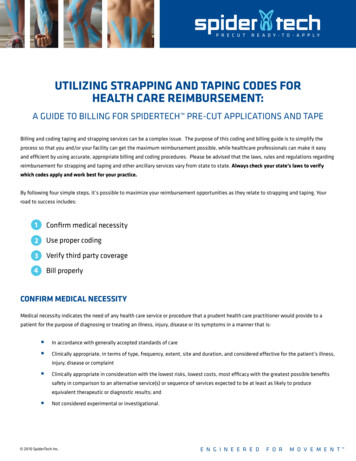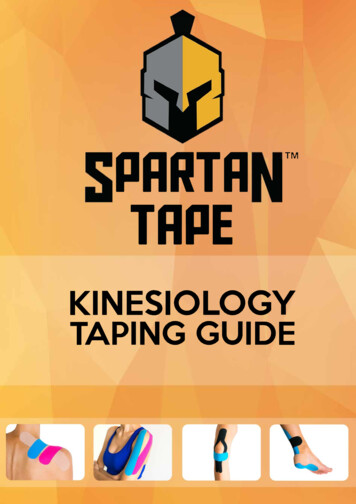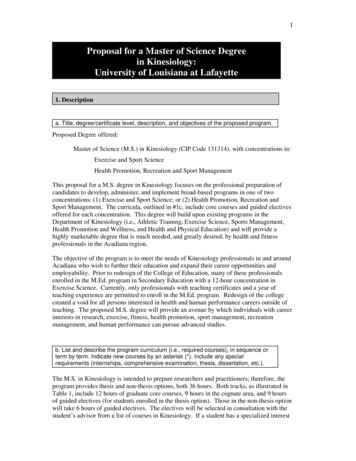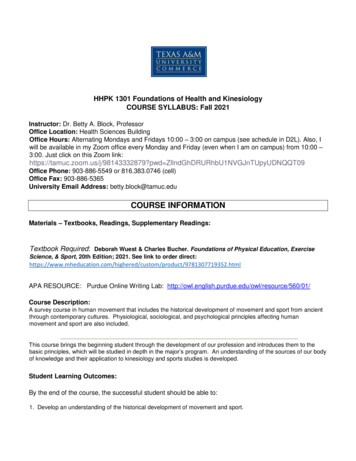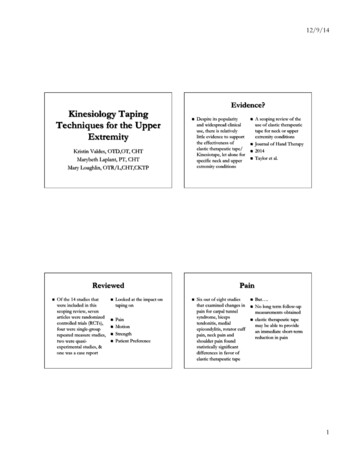
Transcription
12/9/14Kinesiology TapingTechniques for the UpperExtremityEvidence?n Kristin Valdes, OTD,OT, CHTMarybeth Laplant, PT, CHTMary Loughlin, OTR/L,CHT,CKTPReviewedn Of the 14 studies thatwere included in thisscoping review, sevenarticles were randomizedcontrolled trials (RCTs),four were single-grouprepeated measure studies,two were quasiexperimental studies, &one was a case reportn n n n n Looked at the impact ontaping onPainMotionStrengthPatient PreferenceDespite its popularityand widespread clinicaluse, there is relativelylittle evidence to supportthe effectiveness ofelastic therapeutic tape/Kinesiotape, let alone forspecific neck and upperextremity conditionsn n n n A scoping review of theuse of elastic therapeutictape for neck or upperextremity conditionsJournal of Hand Therapy2014Taylor et al.Painn Six out of eight studiesthat examined changes inpain for carpal tunnelsyndrome, bicepstendonitis, medialepicondylitis, rotator cuffpain, neck pain andshoulder pain foundstatistically significantdifferences in favor ofelastic therapeutic tapen n n But .No long term follow-upmeasurements obtainedelastic therapeutic tapemay be able to providean immediate short-termreduction in pain1
12/9/14Impact on range of motionn Impact on strengthFour of these studiesinvolved changes inshoulder range of motionand two studiesexamined cervical rangeof motion. Of these,three studies foundstatistical significance forincreased range ofmotion.n Patient preferencen Only one study examined patients'preference of elastic therapeutic tapecompared to an alternativeintervention (in this case, bandagingfor lymphedema management). Theyfound statistically significant resultsto support the argument that elastictherapeutic tape was preferred byparticipants (p 0.05). Reasonsincluded longer wearing times, lessdifficult usage, increased comfortand convenience.Three studies (one with ahealthy athlete population,and two with athletes withupper limb conditions)examined changes instrength. Two measuredgrip strength, and onelower trapezius musclestrength followingimmediate application ofelastic therapeutic tape. Allfound no statisticallysignificant differencebetween groups.Benefits of Tapingn Another benefit that wasfound as part of thisscoping review was thatelastic therapeutic tape isa treatment modality thathas few side-effects. Noadverse events werereported in any of thesestudies as a result of theuse of elastic therapeutictape.n The findings of thisscoping review suggestthat elastic therapeutictape may play a role inreducing short-term neckand upper extremity painand that it may be amore convenient andcomfortable alternativeto existing conservativetreatments.2
12/9/14Kaneko, S & Takaski, HJOSPT 2011[CASE REPORTTaping Technique]SHOUTA KANEKO, OT, MSc1 HIROSHI TAKASAKI, PT, MSc2Forearm Pain,Diagnosed asIntersection Syndrome,Managed by Taping: ACase SeriesJournal of Orthopaedic & Sports Physical Therapy Downloaded from www.jospt.org at on December 2, 2014. For personal use only. No other uses without permission.Copyright 2011 Journal of Orthopaedic & Sports Physical Therapy . All rights reserved.n Forearm Pain, Diagnosedas Intersection Syndrome,Managed by Taping: A Case SeriesIntersection syndrome, an overuse injury affecting the forearm, hasbeen reported in sporting activity involving the upper limb, suchas rowing, canoeing, racket sports, weight lifting, and skiing.16People who have intersection syndrome report pain, crepitus,and/or swelling in the dorsal forearm, 4 to 8 cm proximal to Lister’stubercle,4 where the muscle bellies of the abductor pollicis longus(APL) and extensor pollicis brevis (EPB) cross the underlying extensorcarpi radialis longus (ECRL) and extensor carpi radialis brevis (ECRB).5 Thepathophysiological basis for intersection! STUDY DESIGN: Case series.! BACKGROUND: Intersection syndrome is anoveruse injury of the forearm. Taping has been described for the management of soft tissue injuries,yet there has been no report for the managementof intersection syndrome using this method. Thepurpose of this case series was, therefore, todescribe the efficacy of taping for the managementof intersection syndrome.! CASE DESCRIPTION: Five patients with intersection syndrome were managed by taping, in aneffort to reduce crepitus induced by thumb movements. Nonstretch sports tape was applied, withan ulnarly directed tension force across the dorsalaspect of the forearm. Taping was performed dailyfor 3 weeks. Follow-up took place at 1, 2, 3, and 4weeks, and at 1 year from the initial consultation.! OUTCOMES: All patients demonstrated com-syndrome is uncertain, but 2 potentialmechanisms are considered. The firstmay be friction between the tendons ofplete elimination of crepitus with the application oftape. Crepitus induced by wrist movements, tenderness over the dorsal forearm, and swelling wereno longer present at 3-week follow-up. Disabilityidentified by the disability/symptom subscale ofthe Disabilities of the Arm, Shoulder and Handquestionnaire decreased at 3-week follow-up,and this reduction was maintained at 4-week and1-year follow-ups.! DISCUSSION: Taping improved symptoms andfunction in this small case series. One possibleexplanation for this improvement may be thealteration of soft tissue alignment.! LEVEL OF EVIDENCE: Therapy, level 4.J Orthop Sports Phys Ther 2011;41(7):514-519,Epub 6 April 2011. doi:10.2519/jospt.2011.3569! KEY WORDS: overuse syndrome , tape,thumb, wristn the APL and EPB, and those of the ECRLand ECRB; the second may be stenosis,due to entrapment within the seconddorsal compartment that houses theECRL and ECRB.4,10,20 Aso et al1 arguedin support of the former mechanism,due to the presence of pain on palpationand crepitus over the intersection of theAPL and EPB, and the ECRL and ECRB,rather than the distal area of the seconddorsal compartment, and due to thumbmovements that accompany crepitus. Akey feature of intersection syndrome onmagnetic resonance imaging (MRI) isperitendinous edema around the firstand second extensor compartment tendons, which extends proximally from theintersection between the APL and EPB,and the ECRL and ECRB.4,14Current management of intersectionsyndrome comprises a combination ofrest, nonsteroidal anti-inflammatorydrugs, and splinting.10,16 One report indicated that 60% of patients respondedto this form of management within 2 to3 weeks.4 However, splinting the wristin 15 to 20 of extension restricts wristand thumb movements, possibly leadingto difficulty with daily living and workactivities.10 Steroid injection is recommended for those failing to respond to1Staff Occupational Therapist, Shinoro Orthopedic, Hokkaido, Japan; PhD candidate, Sapporo Medical University, The Graduate School of Health Sciences, Department ofOccupational Therapy, Hokkaido, Japan. 3PhD candidate, The University of Queensland, School of Health and Rehabilitation Science, Division of Physiotherapy, Queensland,Australia. The patients reported in this study were seen and treated at the Shinoro Orthopedic. All patients provided informed consent to be included in this case series and theiranonymity was guaranteed. The opinions or assertions contained herein are the private views of the authors. The authors affirm that we have no financial affiliation (includingresearch funding) or involvement with any commercial organization that has a direct financial interest in any matter included in this manuscript. Address correspondenceto Hiroshi Takasaki, Division of Physiotherapy, School of Health and Rehabilitation Science, The University of Queensland, Brisbane, Queensland 4072, Australia. E-mail:h.takasaki@uq.edu.auThe taping direction foreach patient wasdetermined by assessingcrepitus during thumbmovements, whilemanual force was appliedacross the soft tissue ofthe dorsal aspect of theforearm.514 july 2011 volume 41 number 7 journal of orthopaedic & sports physical therapyApplication and Wearing of theTapeTaping Techniquen n Tape was then applied in an attemptto replicate and maintain themanually applied force across themuscle-tendon unit. The distal endof the tape was applied first to themuscle bellies of the APL and EPB.Tension was exerted with the freeend of the tape as it was appliedacross the dorsal forearm,perpendicular to its long axisA 2nd layer of tape was used toreinforce the 1st layern The tape wasremoved at night,and each patient wasinstructed tomaintain the tapingregimen for 3 weeksand allowed tocontinue work.The patients were also advisedto perform their normal dailyactivities. Following the 3week intervention, all patientswere advised to use thesymptomatic limb duringactivities of daily living and towork without tape. They wereinstructed to reapply the tape ifthey had any return ofsymptoms3
12/9/14OutcomesScapular TapingThe Effects of Scapular Taping on Electromyographic Muscle Activityand Proprioception Feedback in Healthy ShouldersJiu-jenq Lin,1,2 Cheng-Ju Hung,1 Pey-Lin Yang1All patients reported a complete elimination of crepituswith the application of tape. Crepitus induced by wristmovements, tenderness over the dorsal forearm, andswelling were no longer present at 3-week follow-up.Disability identified by the disability/symptom subscaleof the Disabilities of the Arm, Shoulder and Handquestionnaire decreased at 3-week follow-up, and thisreduction was maintained at 4-week and 1-year followups.n Lin et al showed tapingcaused increased serratusanterior activity anddecreased uppertrapezius activity whilethere was no effect onlower trapezius1 Schooland Graduate Institute of Physical Therapy, College of Medicine, National Taiwan University, 3 F, 17, Xu-Zhou Road, Taipei 100, Taiwan,of Physical Medicine and Rehabilitation; Physical Therapy Center, National Taiwan University Hospital, Taipei 100, Taiwan2 DepartmentReceived 2 August 2009; accepted 12 February 2010Published online 6 July 2010 in Wiley Online Library (wileyonlinelibrary.com). DOI 10.1002/jor.21146ABSTRACT: We investigated the effects of scapular tape on the electromyographic (EMG) activity of the upper trapezius (UT), lowertrapezius (LT), serratus anterior (SA), anterior deltoid (AD), and shoulder proprioception in 12 healthy shoulders. Participants wereblindfolded and required to complete a target end/mid range position with the hand. They performed six trials under two experimentalconditions; no tape and therapeutic tape. EMG activity was measured by surface electrodes, and proprioception was measured by theFASTRAK electromagnetic motion tracking system. Two-way repeated measures ANOVA showed that UT and AD activities decreased2.65% (p 0.001), and SA muscular activities increased 1.9% (p 0.015) in the taping condition. The proprioceptive feedback magnitudewas significantly lower in the taping condition than in the no taping condition (11.9 , p 0.005). Additionally, correlation coefficients werehigher than 0.5 between muscle activity and proprioceptive feedback with the taping condition; UT and magnitude in the mid range task(R 0.516); LT and magnitude in the end range task (R 0.524); and SA and magnitude in the mid range task (R 0.576). The resultssuggest that scapular tape affects the muscle activity of UT, AD, and SA, and that the effects are related to proprioception feedback.These results implicate that the mechanisms by which scapular taping induces effects can be explained by neuromuscular control andproprioceptive feedback factors. 2010 Orthopaedic Research Society. Published by Wiley Periodicals, Inc. J Orthop Res 29: 53–57, 2011Keywords: shoulder proprioception; scapular taping; electromyography; upper trapezius; lower trapezius (LT); serratus anterior (SA);anterior deltoid (AD)Shoulder pain and related glenohumeral joint movement dysfunction are common conditions.1,2 Thesedysfunctions are aggravated by frequent use of the armat or above the shoulder level. Consequently, shoulderimpingement, rotator cuff disease, glenohumeral jointinstability, or adhesive capsulitis may develop.2,3 Scapular or humeral movement alterations are thought to berelated to these conditions. A number of factors havebeen proposed to affect scapular or humeral movement,including soft tissue tightness, muscle activity, and bonyalignment.4,5 Treatments for these complaints aim toaddress these aspects to correct scapular or humeralmovements.4,6Application of tape is widely used in rehabilitationand prevention of these shoulder complaints.7–10 Therationale for taping is that it affords protection and support for a joint during functional movement.7 Althoughit is unclear if tape protects the glenohumeral jointposition,8,9 immediate symptoms improve with scapulartaping and relief of symptoms is greater during functional movement than in static positions.8,10Evidence to support that control of the scapula canbe altered by taping is limited.8,11 Selkowitz et al.8found that compared to the no taping condition, scapuAssociate Professor (School and Graduate Institute of Physical Therapy) and Adjunct Physical Therapist (Department ofRehabilitation and Physical Medicine and Physical TherapyCenter). Correspondence to: Jiu-jenq Lin (T: 886-2-33668126; F: 886-233668161; E-mail: jiujlin@ntu.edu.tw)lar taping decreased upper trapezius (UT) activity andincreased lower trapezius (LT) activity in people withsuspected shoulder impingement during a functionaloverhead-reaching task. In contrast, using a scapulartaping technique on healthy individuals, Alexander etal.11 found a decreased amplitude of the LT H-reflex,indicating an inhibitory influence of taping. On theother hand, Cools et al.7 found no significant differencesbetween scapular taping and no taping for the upper,middle, and LT, and the serratus anterior (SA). Tapemay adjust muscle activity via proprioceptive feedback,a sensory modality allowing a person to identify theposition of a limb in space and perceive limb motion.12Subjects with stiff shoulder have reduced proprioceptivefeedback during arm elevation,13 but others reportedthat scapular taping did not affect joint repositioningduring active shoulder movements.9 Just how electromyography (EMG) and proprioception are changedby taping and whether the altered EMG amplitude isassociated with proprioception should be determined.The purpose of our study was to determine if EMGactivity in the scapular muscles is influenced by theapplication of tape over the muscle belly of the UT muscle by removing the confounding effects of pain andby including an asymptomatic group. Based on clinical assumptions and previous investigations,7,8,14–17we assumed that with taping, UT activity woulddecrease and the LT/SA would increase. Additionally,we hypothesized that taping would improve proprioception feedback. Although previous studies8,15,16 partiallysupported these hypotheses in symptomatic subjects, 2010 Orthopaedic Research Society. Published by Wiley Periodicals, Inc.JOURNAL OF ORTHOPAEDIC RESEARCH JANUARY 2011Tape Application53Shoulder taping to improve ROMRESEARCH REPORTn n n Used an “I” shapedKinesiotapeSubjects were asked tofully retract and depresstheir scapula andmaintain the posture.At the same time, weapplied the Kinesiotapefrom the inferior marginof the medial 1/3 of theclavicle to T12 with fullstretching of the tapen The results suggestthat KT can increaseshoulder ROM.Stretching was notfound to have aneffect on shoulderROM, regardless ofwhether it was usedalone or incombination withKT.The Effects of Kinesio Tape and Stretchingon Shoulder ROMAi Ujino, MS, ATC, LAT; Lindsey E. Eberman, PhD, ATC, LAT; Leamor Kahanov, EdD, LAT,!4# #HELSEA 2ENNER -3 !4# ,!4 AND 4IMOTHY EMCHAK 0H ,!4 !4# s )NDIANAState UniversityContext: Kinesio tape (KT) is theorized to increase joint range of motion (ROM) by a mechanism that differs from that of stretching exercises. Objective: To investigate the combined effects of KT and stretchingon shoulder ROM. Participants: Healthy volunteers (n 71) ranging in age from 18–40 years, with no history of shoulder injury (29 males and 42 females). Interventions: Participants were randomly assigned tothree treatment groups (KT only, Stretch, and KT/Stretch). Main Outcome Measures: Posttreatment ROMmeasurements were obtained with a digital inclinometer on day 1 and day 4. Results: Analysis of varianceidentified a significant difference among groups for the magnitude of change in shoulder ROM, F(2,68) 3.268, p 0.044, which was greatest for the KT group (mean change 9.20 17.91). Conclusion: Theresults suggest that KT can increase shoulder ROM. Stretching was not found to have an effect on shoulderROM, regardless of whether it was used alone or in combination with KT.Kinesio tape (KT) is a treatment methodtheorized to improve joint range of motion(ROM) in the neck and lumbar spine, 1-4but the effect of KT on the shoulder hasnot been investigated.Shoulder injuries thatare common in athletics include instabilKinesio tape alone increased glenohumerality, impingement, andtotal arc of motion in healthy individuals.rotator cuff tendinopathy.5 The complexity ofStretching and the combination of Kinesioshoulder girdle functiontape and stretching did not change range ofcontributes to the varimotion in healthy populations.ety of injury types, anyStretching and the combination of Kinesioof which may be associtape and stretching may have a greaterated with restriction ofimpact in unhealthy, motion restrictedglenohumeral ROM.5-9patients.Shoulder ROM is highlyinfluenced by scapulardyskinesis/instability, muscle tightness,tendon thickening, and capsular restrictionsresulting from scar tissue formation.5,9-12KT is currently used in clinical practice inKey Pointsconjunction with joint mobilization, ROMexercises, and active/passive stretches, butno evidence of a beneficial effect on shoulderROM is available.1-4,13KT is believed to have therapeutic effectsthat promote edema reduction, pain control,increased ROM, and blood and lymphaticflow within underlying tissue.2,14-22 Becauseof its elasticity, KT is theorized to increaseinterstitial space by lifting the skin over thetargeted treatment area, which is the mechanism believed to decrease pain, increaseblood and lymphatic circulation, and increasejoint mobility.14,15,23,24 Multiple therapeuticinterventions are often administered concomitantly,13 which provided the rationalefor assessment of KT with stretching forimprovement of shoulder ROM.25-29Procedures and FindingsWe used a quasi-experimental post-testdesign with three groups: (a) KT only (KT), 2013 Human Kinetics - IJATT 18(2), pp. 24-2824 MARCH 2013INTERNATIONAL JOURNAL OF ATHLETIC THERAPY & TRAINING4
12/9/14Tape neededOne “I” strip of tape cut½ lengthwise until 1 ½inches from one endOne “I” shaped pieceY stripn The upper portion of the“Y” strip was pulleddiagonally in a superiorand anterior direction.Prior to application ofthe lower portion, theshoulder was positionedin ERTechniquen One “I”strip of tapecovered the skin surfacefrom the anterior portionof the glenoid rim to theinferior border of thesurface from the medialportion of the spine ofscapula to the anteriorportion of the glenoidrim with 50% stretchAnterior Viewn n Analysis of varianceidentified a significantdifference among groupsfor the magnitude ofchange in shoulder ROM,F(2, 68) 3.268, p 0.044, and theKT group demonstratedthe greatest increase inROM between day 1 andday 45
12/9/14To Improve ROM with AdhesiveCapsulitisInnovative Journal of Medical and Health Science 3: 2 March – April (2013) 45 - 51.Contents lists available at www.innovativejournal.inINNOVATIVE JOURNAL OF MEDICAL AND HEALTH SCIENCEJournal /ijmhsEFFICACY OF KINESOTAPING AS AN ADJUNCT TO POSITIONAL STREATCHING OFCORACOHUMERAL LIGAMENTS IN PATIENTS WITH PRIMARY ADHESIVECAPSULITIS.Pradeepshankar1, Renukadevi .M 2, Nirnay Gowda2,1J.S.S.4,Harish Pai5.College of Physiotherapy, Department of Physiotherapy, J.S.S. Hospital, mysore. Karnataka , IndiaARTICLE INFOCorresponding Author:PradeepshankarAssociate Professor,J.S.S. College of Physiotherapy,Department of Physiotherapy, J.S.S.Hospital, mysore. Karnataka , IndiaPradeerenu1921@gmail.comKeywords: Kineso Tape, PositionalStretching , Coracohumeral LigamentABSTRACTAdhesive capsulitis is a condition of uncertain aetiology characterized by aprogressive loss of both active and passive range of motion of shoulder.Approximately 2-3 % of adults aged between 40-65 years develop adhesivecapsulitis with greater occurrence in women than man. The Etiological factorscontributing for primary adhesive capsulitis is iopathic in nature. Howeverthe pathological changes in primary adhesive capsulitis has been proposed bymany researchers, According to Desai the primary area of pathology inadhesive capsulitis is Coracohumeral ligament (CHL) and rotator interval.Various physiotherapy intervention has being applied to adhesive capsulitis ofshoulder not considering importance of primary pathology of coracohumeralligament and scapula dyskinesis effect on adhesive capsulitis. So the study isproposed to find the efficacy of kineso tape adjunct to positional streatching ofCHL against only CHLpositional stretching in adhesive capsulitis.Methodology; Subjects fulfilling the inclusion criteria were randomly dividedinto two .Eachsubject underwent assessment to predict the base line values of parameterslike VAS, and ROM and DASH SCORE. Level of inferior angle of scapula withrespect to T7 level noted in neutral standing position. Group A underwenttreatment with positional stretching for CHL alone while Group B subjectswere treated with kinesio tape in addition to positional stretching of CHL. Thesubjects received 3 sessions of treatment per week for 4 weeks. Result shownhighly significant improvement in all parameter pre and post of each group.Between group CHL positional streatching with Kineso tape shown significantimprovement in all parameter than only CHL positional streatching.Conclusion; kinesotape with CHL positional stretching is effective inovercome pain and disability in patient suffering from adhesive capsulitis.n Initially the duration of stretch isapplied for 5 min and progressed to15 min by the end of second weekKinesotape with CHLpositional stretching iseffective in overcomepain and disability inpatient suffering fromadhesive capsulitis. 2013, IJMHS, All Right ReservedINTRODUCTIONAdhesive capsulitis is a condition of uncertainaetiology characterized by a progressive loss of both activeand passive range of motion of shoulder1. Approximately 23 % of adults aged between 40-65 years develop adhesivecapsulitis with greater occurrence in women and usuallynon dominant arm is involved2. The primary adhesivecapsulitis is Etiologic factors contributing is idiopathic innature. However the pathological changes in primaryadhesive capsulitis has been proposed by manyresearchers as follows According to DePalma stated thatpathological changes in adhesive capsulitis occur primarilyin normally flexible fibrous capsule, which becomesprogressively non elastic and shrunken. Initially thecapsule becomes contracted, with loss of inferior capsularfold. Later stages there will be increased capsular fibrosisand resulting in loss of elasticity of tissues. J. S.Neviaser3stated that the absence of synovial fluid in theglenohumeral joint , tightly contracted and thickened jointcapsule, cellular changes of chronic inflammation withfibrotic and perivascular infiltration in the synovial layer ofcapsule with reparative inflammatory process are thepathological process of adhesive capsulitis. According toDesai the primary area of pathology in adhesive capsulitisis Coracohumeral ligament (CHL) and rotator interval9Coracohumeral ligament plays a major role incounteracting the downward pull of gravitational force onarm and in maintaining glenohumeral relation. Theyproposed that (mengiardis, Omari et al) in adhesivecapsulitis there will be fibroblastic proliferation andthickening of coracohumeral ligament and the capsule atthe rotator cuff interval there will be complete obliterationof the fat triangle under the coracoid process are the most45n For deltoid muscle; a kinesio Y strip isapplied with paper-off tension from insertionto origin. The first tail of y strip is applied tothe anterior Deltoid with the arm inhorizontal abduction and external rotation,along the outer border of the anterior deltoidto acromioclavicular joint. The second tail isapplied to posterior deltoid with the arm inhorizontal adduction and internal rotation,along the outer border of posterior deltoid tothe acromioclavicular joint. Last 2 inchesbeen applied without tension. For assistingexternal rotation by releasing tension ofinternal rotation; kinesio Y strip is applied tothe base of posteriolateral border of humerusn Very light to lighttension (15-25%) isapplied to the tails of thekinesio Y strip. Thesuperior tail is appliedinferior to clavicle andend of thesternoclavicular joint andthe inferior tail is appliedfollowing the lowerfibers of the pectoralismajor to thecostochondral joint6
12/9/14n Lastly, we performed the taping ofthe teres minor muscle. The I-typestrip was placed on the lower facetof the greater tuberosity of thehumerus with no tension. Then, thepatient abducted the shoulder inhorizontal flexion with internalrotation. We placed the rest of thestrip along the axillary border ofthe scapula with light (15–25%)tensionKinesiology Taping vs. AthleticTapingATHLETIC TAPINGStabilizationn Restrictive/supportiven Restricts fluid exchangen Worn a few hrsn Examples: McConnelltape, Leukotape, EnduraSports Tapen Kinesiology Taping-Elastic properties-Weight, thickness, elasticity of tape similar to skin-One way longitudinal stretch-Allows free movement and for normal tissueexpansionKINESIOLOGYTAPINGn Stabilizationn Allows mobilityn Increased circulationn Withstands fluidsn Can be worn about 3daysn Examples: Kinesiotape,Rock Tape, Spider TechKinesiology Taping benefitsn n n n n n Provides supportReduces muscle fatigueStimulates muscles to strengthen when weakAfferent Sensory Stimulation( pain relief)Increases vascularity/improves lymphatic flow(clearing inflammation)Promotes movement across kinetic and fascialchains7
12/9/14With inflammation, tissue restrictions or otherlimitations, there becomes increased resistanceand decreased space between the skin, fascia andmuscle.Contraindications/Precautionsn n n n n n n DVTOpen WoundsInfectionFragile/sensitive skinHeart FailureCHF with edemaRespiratory Conditionsn n n n n n DiabetesKidney DiseaseUlnar side of elbow(caution due to ulnarnerve)Currently undertreatment for CancerPregnancySkin irritation8
12/9/14Things to remembern n n n n Tell pts never blow dry the tapeTell pts do not use hot packs or heat treatmentswith the tape onNo oils or lotions on skin when applyingMay need to shave hair off the affected area tohave good contactCheck skin before applyingStretch and Recoil Principlesn n n n Stretch the tape away from the anchor and thetail will recoil back to the anchorTo encourage shortening of a muscle (tofacilitate) apply tape ORIGIN to INSERTIONTo encourage elongation of a muscle (to inhibit)tape INSERTION TO ORIGIN.In cases of edema applications, lymphatic flowwill be directed towards the anchorGeneral Principlesn n n n n n n Anchors/ends are applied with no tensionTape is made to stretch in the longitudinal direction onlyTape can be left on 3-5 daysSkin needs to rest at least 24 hrs after tape application, beforereapplication.Remove tape immediately and gently if irritation/sensitivity. (cando 24 hr. test patch with no tension)Teach pts how to remove the tape.Must wait 30 min before going in a pool or doing a sweatyworkout in order for tape to adhere well.AnchorNo tensionTailPortion of tapewhere tension isappliedEndNo tensionTypically 1-2inchesTypically 1-2inchesIn case of highertension( 50%),use rule of thirdsIn cases of highertension( 50%),use rule of thirds9
12/9/14More General Principlesn n n Majority of techniques 15-25 percent tension.(Most skin irritation due to too much tension.)Rule of thirds for higher tension taping( 50%tension)For all basic application techniques, the muscle/tissue to be treated should be put in a stretchedposition in combination with the stretchcapabilities of the tape. This will createconvolutions as the skin is lifted.Basic Tape Cutsn n n n Shapes of Tape CutsI strip: Tension is focused within the therapeuticzone directly over the target tissueY strip: tension is dispersed through andbetween two tails over target tissueX cut: Tension is focused directly over targettissue and dispersed through tailsFan cut: Tension is dispersed to over targettissue through multiple tailsButtonhole cutsn Can be used so that the tape can be anchoredover the digits10
12/9/14Tape Applicationn n n n Prior to taping, make sure skin is cleanRound edges of tapeTypically the joint is moved through a full activeor passive motion to provide a stretch on thetissue while tape is applied. In some cases,alternate positioning may be recommended.Lightly rubbing the tape activates the adhesiveRemoval of Tapen n n n Types of applicationsn n General muscle applicationsAdvanced Corrective techniques-mechanical correction-fascia correction-space correction-ligament/tendon correction-functional correction-lymphatic correctionRemove in direction of hair growthMay gently roll it off the skin using 1 hand whileother hand supports the skinMay be removed while showering or in a bathCan use baby oil, canola oil, moisturizer, handlotion to assist with tape removalHow much tension?n Paper off tension 10-15%MUSCLE APPLICATIONS-to inhibit 15-25%, insertion to origin-to facilitate 15-35%, origin to insertionn n n n n n n ADVANCED TECHNIQUESSpace correction-10-35%Fascial correction-10-25% for superficial fascia (advanced oscillatingtechnique)Lymphatic correction-0-20%Tendon correction 50
Shoulder pain and related glenohumeral joint move-ment dysfunction are common conditions.1,2These dysfunctions are aggravated by frequent use of the arm at or above the shoulder level. Consequently, shoulder impingement, rotator cuff disease, glenohumeral joint u-







